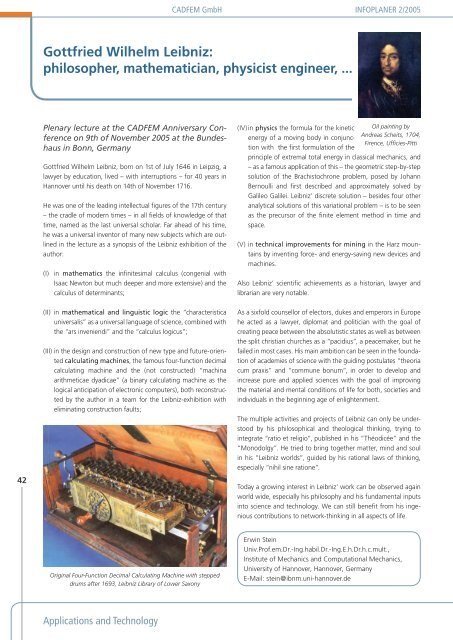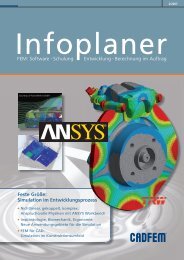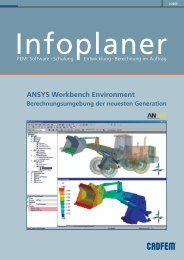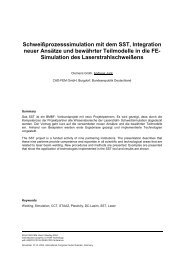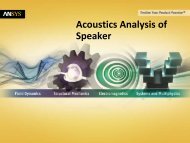FEM: Software • Schulung Entwicklung • Berechnung ... - CADFEM.CH
FEM: Software • Schulung Entwicklung • Berechnung ... - CADFEM.CH
FEM: Software • Schulung Entwicklung • Berechnung ... - CADFEM.CH
Sie wollen auch ein ePaper? Erhöhen Sie die Reichweite Ihrer Titel.
YUMPU macht aus Druck-PDFs automatisch weboptimierte ePaper, die Google liebt.
42<br />
CAD<strong>FEM</strong> GmbH INFOPLANER 2/2005<br />
Gottfried Wilhelm Leibniz:<br />
philosopher, mathematician, physicist engineer, ...<br />
Plenary lecture at the CAD<strong>FEM</strong> Anniversary Conference<br />
on 9th of November 2005 at the Bundeshaus<br />
in Bonn, Germany<br />
Gottfried Wilhelm Leibniz, born on 1st of July 1646 in Leipzig, a<br />
lawyer by education, lived – with interruptions – for 40 years in<br />
Hannover until his death on 14th of November 1716.<br />
He was one of the leading intellectual fi gures of the 17th century<br />
– the cradle of modern times – in all fi elds of knowledge of that<br />
time, named as the last universal scholar. Far ahead of his time,<br />
he was a universal inventor of many new subjects which are outlined<br />
in the lecture as a synopsis of the Leibniz exhibition of the<br />
author:<br />
(I) in mathematics the infi nitesimal calculus (congenial with<br />
Isaac Newton but much deeper and more extensive) and the<br />
calculus of determinants;<br />
(II) in mathematical and linguistic logic the “characteristica<br />
universalis” as a universal language of science, combined with<br />
the “ars inveniendi” and the “calculus logicus”;<br />
(III) in the design and construction of new type and future-oriented<br />
calculating machines, the famous four-function decimal<br />
calculating machine and the (not constructed) “machina<br />
arithmeticae dyadicae” (a binary calculating machine as the<br />
logical anticipation of electronic computers), both reconstructed<br />
by the author in a team for the Leibniz-exhibition with<br />
eliminating construction faults;<br />
Original Four-Function Decimal Calculating Machine with stepped<br />
drums after 1693, Leibniz Library of Lower Saxony<br />
Applications and Technology<br />
(IV) in physics the formula for the kinetic<br />
energy of a moving body in conjunction<br />
with the fi rst formulation of the<br />
Oil painting by<br />
Andreas Scheits, 1704,<br />
Firence, Uffi cies-Pitti<br />
principle of extremal total energy in classical mechanics, and<br />
– as a famous application of this – the geometric step-by-step<br />
solution of the Brachistochrone problem, posed by Johann<br />
Bernoulli and fi rst described and approximately solved by<br />
Galileo Galilei. Leibniz’ discrete solution – besides four other<br />
analytical solutions of this variational problem – is to be seen<br />
as the precursor of the fi nite element method in time and<br />
space.<br />
(V) in technical improvements for mining in the Harz mountains<br />
by inventing force- and energy-saving new devices and<br />
machines.<br />
Also Leibniz’ scientifi c achievements as a historian, lawyer and<br />
librarian are very notable.<br />
As a sixfold counsellor of electors, dukes and emperors in Europe<br />
he acted as a lawyer, diplomat and politician with the goal of<br />
creating peace between the absolutistic states as well as between<br />
the split christian churches as a “pacidius”, a peacemaker, but he<br />
failed in most cases. His main ambition can be seen in the foundation<br />
of academies of science with the guiding postulates “theoria<br />
cum praxis” and “commune bonum”, in order to develop and<br />
increase pure and applied sciences with the goal of improving<br />
the material and mental conditions of life for both, societies and<br />
individuals in the beginning age of enlightenment.<br />
The multiple activities and projects of Leibniz can only be understood<br />
by his philosophical and theological thinking, trying to<br />
integrate “ratio et religio”, published in his “Théodicée” and the<br />
“Monodolgy”. He tried to bring together matter, mind and soul<br />
in his “Leibniz worlds”, guided by his rational laws of thinking,<br />
especially “nihil sine ratione”.<br />
Today a growing interest in Leibniz’ work can be observed again<br />
world wide, especially his philosophy and his fundamental inputs<br />
into science and technology. We can still benefi t from his ingenious<br />
contributions to network-thinking in all aspects of life.<br />
Erwin Stein<br />
Univ.Prof.em.Dr.-Ing.habil.Dr.-Ing.E.h.Dr.h.c.mult.,<br />
Institute of Mechanics and Computational Mechanics,<br />
University of Hannover, Hannover, Germany<br />
E-Mail: stein@ibnm.uni-hannover.de


